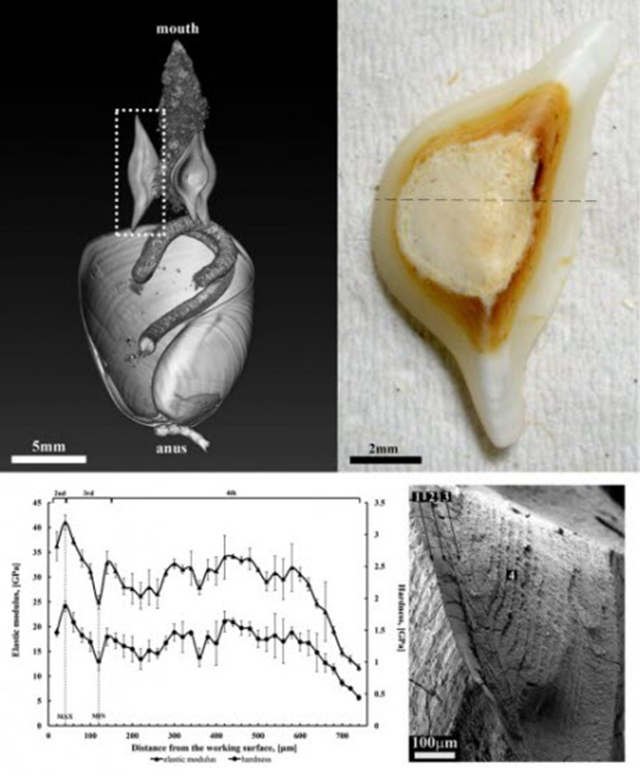Newswise — WASHINGTON, D.C., October 19, 2015 — Whereas human and many animals use teeth to crush or grind food as an initial part of the digestive process, some species such as birds that lack teeth grind food inside the gizzard – a structure between the mouth and the stomach – with the help of stones. Another interesting adaptation of this approach to digestion has evolved in most of the Cephalaspidean gastropods, a common type of marine mollusks, who use hardened plates that line the gizzard for crushing or grinding.
Recently, a team of researchers from Weizmann Institute of Science and Israel Oceanographic and Limnological Research and National Institute of Oceanography, Israel has studied the structural and mechanical properties of gizzard plates of the cephalaspid Philine quadripartita, achieving a better understanding of how the gizzard plates function in the digestion process and an insight into the connection between the biological function and the mechanical properties of biological composites. The discovery may help scientists develop novel materials with desired mechanical functions. This work will be presented at AVS 62nd International Symposium and Exhibition, being held Oct. 18-23, 2015 in San Jose, Calif.

The upper left shows a CT image of whole mollusk, while the upper right showed a zoomed in optical image of the plate highlighted with dotted lines. The bottom images show a cross-section of the species and the corresponding profile of mechanical properties. Image credits: Sidney Cohen/Weizmann Institute of Science
"This work, the thesis project of graduate student Margarita Kovtanyuk, reports a detailed study of the ultrastructure and the hardness and elastic modulus variation of the gizzard plates of Philine quadripartite, showing that the plates are used to crush, not grind, the food, which is different from the grinding function of teeth," said Sidney Cohen, director of the surface analysis laboratory in the Department of Chemical Research Support at the Weizmann Institute of Science, Israel.
Cohen said Philine quadripartita has three millimeter-sized, hardened plates inside the gizzard: two paired plates that are mirror images of each other and one smaller unpaired plate. To better understand the functions of gizzard plates in the digestion process, the Weizmann team used a variety of chemical, mechanical and structural techniques to study the gizzard muscle system, the food present at different stages of the digestion process and the working surface of the gizzard plates.
Direct experimental observation showed that small, shelled prey was crushed by the gizzard plates before entering the stomach, the two paired plates serving as crushing surfaces. The researchers also found that the gizzard plate has a complex, four-layered structure, whose elastic moduli, a measure of how well a material holds up to wear, and hardness increase with distance from the surface. The stiffest layer of a gizzard plate is 40 to 50 microns (one millionth of a meter) below the working surface, unlike most teeth where the stiffest layer is at the surface.
"Grinding requires very hard and stiff working surfaces facilitating the break-down of materials between surfaces, while besides hardness and stiffness, crushing also requires some degree of surface resilience to protect working surfaces from crumbling apart under high pressure," Cohen explained.
A surface that is more compliant or springy can better accommodate itself to stress-induced deformation and avoid self-damage. Although compared to sea urchin teeth used to obtain food by grinding rocky surfaces, the gizzard plate is much less hard and stiff, the unique structural characteristics of the plates indicate that nature has designed them for different tasks, Cohen said.
In addition, the researchers found that the differences in mechanical characteristics and biological functions of the surfaces are related to the difference in mineral composition of the materials as well. For instance, gizzard plates are found to be composed of a mixture of amorphous minerals–calcium carbonate and calcium phosphate, while sea urchin teeth consist of crystalline magnesium-bearing calcite.
Rigorous analysis of the elasticity indices (a parameter telling the wear resistance of a material) of the gizzard plates as compared with sea urchin teeth and synthetic calcite showed the principal difference between the grinding and the crushing functions of biological composite materials. The researchers found that although both of these functions require high toughness, the grinding function requires harder surfaces to avoid excessive wear.
The digestive system of marine mollusks is an excellent example of the interplay between chemical and structural composition with the biological function, Cohen noted. Investigation of this unique organism at small scales has revealed how its functionality is optimized for its crushing function. Comparing and contrasting this species to other organisms with varying roles reveals new insights into the specific requirements of biological mechanical functionality.
"The solutions evolved by organisms during hundreds of millions of years have produced sophisticated functional materials under ambient conditions, with unexpected and much more innovative design than the best man-produced solutions," Cohen said. "Nature’s design is multi-faceted and complex. We now have the tools to reveal some of her secrets, which allows us to better understand and mimic nature, helping scientists develop better materials with desired functions."
